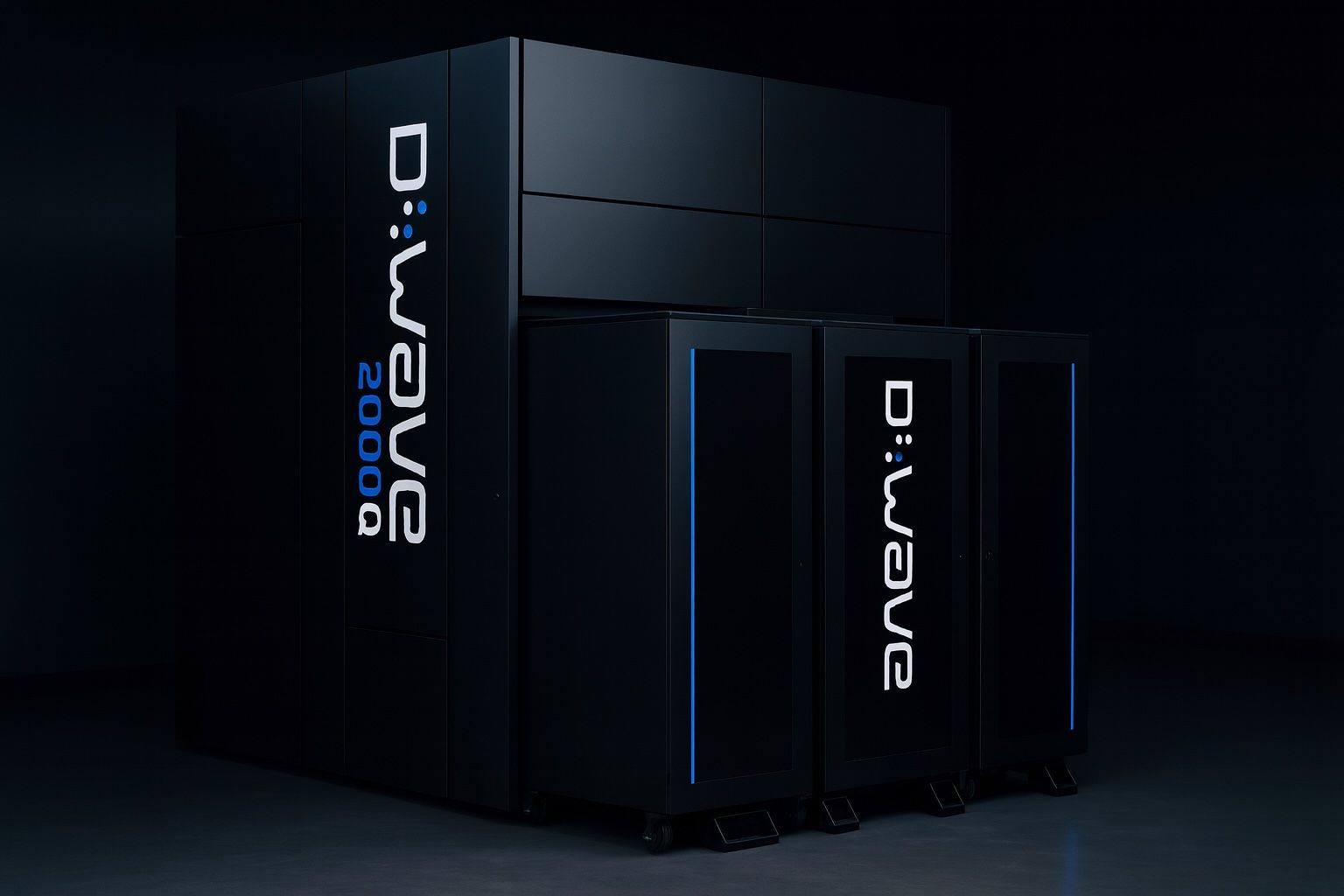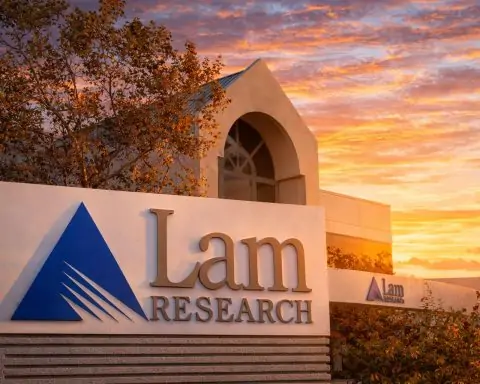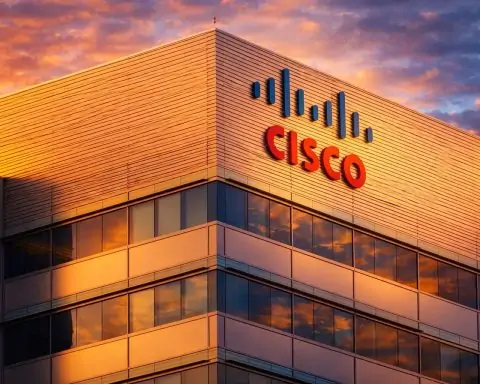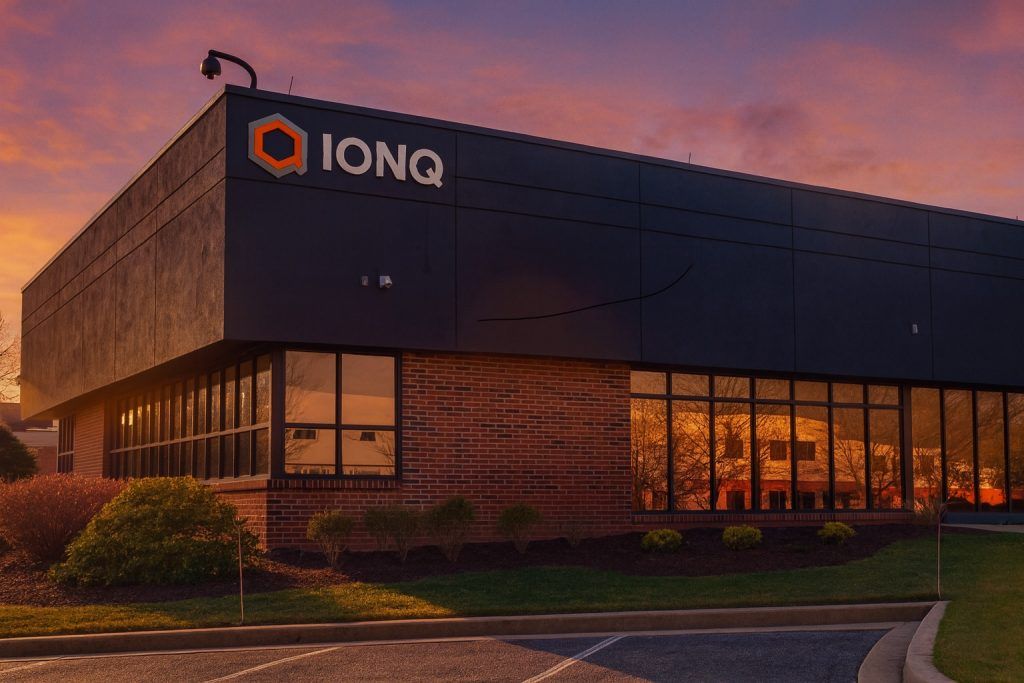- Price & Rally: QBTS closed around $27.29 on Oct. 22, 2025 (down ~15% that day) [1]. The 52-week range is about $0.98 – $46.75 [2] [3]. D-Wave’s share price ran from under $1 in late 2024 to a $46.75 intraday peak on Oct. 15, 2025 — roughly a 3,000% jump in one year [4] [5]. Even after the recent pullback, QBTS is up ~300% year-to-date [6] [7].
- Market Cap & Sales: At its mid-October highs, QBTS’s market capitalization was on the order of $10–14 billion [8] [9] – hundreds of times the company’s sales. D-Wave’s revenue is still tiny (around $18 million in H1 2025) [10], and it remains unprofitable. Analysts caution the stock trades on momentum rather than fundamentals [11] [12].
- Recent Moves: On Oct. 15 D-Wave announced a €10 million Advantage2 quantum computer deal with Swiss Quantum Technology (for Italy’s new “Q-Alliance” hub) [13] [14]. On Oct. 20 the company said it will redeem ~5 million SPAC-era warrants by Nov. 19 at $0.01 each, streamlining its capital structure (if all warrants are exercised, ~7.2 M new shares, ~2.1% dilution) [15] [16]. On Oct. 22 D-Wave announced quantum-computing workshops at Italian universities, part of training for its new system there [17]. Other recent news includes successful pilot projects (e.g. a UK police scheduling demo) and growing bookings, highlighting D-Wave’s push from R&D toward real-world use [18] [19].
- Analyst Ratings: Wall Street is divided. Roth Capital raised its 12-month target to $50 (Buy) after the Europe deal [20]. B. Riley upped its target to $33 [21]. By contrast, Piper Sandler’s analysts put a $22 target (Overweight) and Benchmark kept a $20 target (Buy) [22]. TipRanks confirms a recent average target near $50 [23], but consensus is closer to the mid-$20s [24], implying downside if momentum fades. MarketBeat notes that Weiss Research and Zacks have issued or reiterated Sell/Strong-Sell ratings on QBTS, warning of its “sharp swings, big losses, and extraordinarily rich valuation” [25].
- Market Reaction: QBTS has seen massive volatility. In the week after the mid-Oct peak, the stock plunged ~35% (from ~$44.78 to ~$28 by Oct. 22) [26]. On Oct. 21, shares fell ~6.4%, and on Oct. 22 they dropped about 15% [27]. Mad Money host Jim Cramer cautioned investors not to “be fooled” by snapback rallies in speculative quantum stocks, advising to sell into any bounce [28] [29]. MarketBeat analysts likewise say investors should “brace for increased volatility” and watch whether the “quantum rally has true staying power” [30].
Latest Stock Price and Performance
D-Wave’s stock has been on a wild ride. After spending most of 2024 under $5, QBTS erupted in 2025. It surged into the mid-$40s in mid-October, hitting $46.75 on Oct. 15 [31]. That came after several back-to-back gains – for instance, a 23% jump on Oct. 13 alone [32]. By Oct. 22, the stock had retreated; it closed around $27.29 on Oct. 22 [33] and traded near $26.78 in after-hours that evening [34]. Reuters reports QBTS “trading lower” at $27.29 as of Oct. 23 [35]. In total, QBTS is up roughly 300% so far in 2025 [36], but its gains have come in extreme swings (10–20% moves day-to-day [37]). Volume has been heavy, reflecting a classic “speculative frenzy.”
Despite recent losses, the stock’s rally makes D-Wave one of the highest-flying names of 2025. However, this also puts it on shaky ground: analysts note that the stock’s price targets (generally in the $20–30 range) lie well below the current level [38]. In short, QBTS’s surreal gains have outpaced its fundamentals, setting the stage for volatile trading in the near term [39] [40].
Recent News & Developments
Several catalysts have driven the QBTS action this month. On October 15, D-Wave announced a major European hardware sale: a €10 million contract with Swiss Quantum Technology SA to install a 4,400+ qubit Advantage2 quantum annealing system in Italy [41]. This deal — for Italy’s new “Q-Alliance” quantum hub — is D-Wave’s largest European system sale to date. CEO Alan Baratz praised it as a “critical component” for Europe’s quantum development [42]. One week later (Oct. 22), D-Wave revealed it will run hands-on quantum computing seminars at Italian universities (Insubria and USI) to train local researchers [43]. Baratz said this will help make Italy “a global hub of quantum innovation,” blending hardware deployment with researcher education [44].
On October 20, the company announced it will redeem all ~5 million of its outstanding public warrants (at $0.01 each) on Nov. 19 [45]. These warrants (from D-Wave’s SPAC merger) give holders the right to buy shares at $11.50. D-Wave’s plan forces warrant holders to act or lose them, simplifying the equity structure. If all warrants are exercised, roughly 7.2 million new shares (~2.1% dilution) would be issued [46]. Management says this streamlines the cap table, but traders note the redemption news briefly pushed the stock down (~10% on Oct. 21) as some saw it as mildly dilutive [47].
Other recent developments include ongoing proof-of-concept projects. Earlier in 2025, D-Wave highlighted a UK law-enforcement pilot: using its hybrid quantum platform to optimize police dispatch scheduling. This project reportedly cut average emergency response times by ~50% (4 minutes vs. 4 months for a computation) [48]. Baratz touted it as proof that “hybrid-quantum computing… is beginning to show real-world potential” [49]. While such projects are small in revenue, they help D-Wave demonstrate practical use cases. On the flip side, insider activity has drawn attention: MarketBeat notes that Baratz sold about 32,000 shares in late October, a move that coincided with falling volume and price [50].
Taken together, the recent news (Europe deal, warrant plan, training, pilots) show D-Wave aggressively seeking commercialization beyond R&D. These announcements drove the mid-October rally – but they also underscore how sensitive QBTS is to every headline in this hype-driven market [51].
Analysts & Expert Insights
Wall Street views on D-Wave are polarized. On the bullish side, Roth Capital analyst Suji Desilva (a known quantum specialist) updated his model after the Italy deal. On Oct. 15 he raised his 12-month target to $50 (maintaining a Buy) [52], citing D-Wave’s “growing commercial traction” and noting this was the first European Advantage2 deployment [53]. B. Riley’s Craig Ellis (who attended a recent quantum industry conference) similarly bumped his target to $33 [54]. These analysts highlight D-Wave’s expanding customer base (from Volkswagen to NASA to the new Swiss partner) as evidence of progress. Piper Sandler, meanwhile, recently set a $22 target (Overweight) and Benchmark kept a $20 target (Buy) [55], pointing to the company’s momentum and industry leadership.
But plenty of experts urge caution. The average price target across analysts is only in the mid-$20s [56] – far below today’s trading levels – suggesting significant downside if sentiment shifts. In October, Weiss Research reiterated a Sell rating, and Zacks cut QBTS to Strong Sell, explicitly warning of the stock’s “extraordinarily rich valuation” and “sharp swings” [57]. An Investor’s Business Daily note warned that QBTS could fall another 10–15% from current levels if the speculative frenzy cools [58]. Indeed, May reports (pre-rally) pegged D-Wave’s “fair value” at only a few dollars per share [59].
Media pundits echo these divides. Motley Fool notes that billionaires and hedge funds (like Paul Tudor Jones and Ken Griffin) have been accumulating QBTS, chasing momentum [60]. By contrast, CNBC’s Jim Cramer on Oct. 21 explicitly warned investors “not [to] be fooled” by the quantum hype [61] [62]. He said that speculative pockets (quantum, AI chips, etc.) might “not go down without a fight” and advised selling into any short-term rebounds [63] [64]. Similarly, a MarketBeat analysis advises readers that “investors should brace for increased volatility” and that the coming months will test whether this quantum stock boom has “true staying power” [65].
Overall, analysts’ quotes paint a picture of extreme sentiment. Bulls point to real deals and technology leadership, while bears highlight sky-high valuations and the lack of profits. As one report put it, QBTS has become “a poster child” of 2025’s quantum-investing frenzy [66] – for better or worse.
News Coverage & Industry Reaction
Specialized media have been all over the D-Wave story. TechStock² (TS2) ran multiple deep-dive pieces this month, dubbing the scene a “Quantum Gold Rush.” TS2 charts show D-Wave’s parabolic rise and fall, and its authors emphasize the frenzy: “investors have flocked to anything related to quantum,” even as “some say the stock is significantly overvalued” [67]. Their headlines question sustainability (“but is it sustainable?”) and highlight every new development (Europe deal, warrant redemption, educational push) [68] [69].
Mainstream outlets also covered D-Wave tangentially. Reuters noted back in March 2025 that an upbeat earnings forecast and science breakthrough had sent QBTS higher [70]. In mid-October, Reuters listed D-Wave on its stock quote page and noted the new contracts in passing [71]. Financial blogs and newswires like Investing.com/MarketBeat have parsed every blip: one analysis titled “Hype Fades, Fundamentals Take Hold” explained the post-rally pullback and investor skepticism [72]. Meanwhile, Benzinga reported Cramer’s comments and daily price swings, giving context to investors watching the carnage [73].
Overall, media coverage has oscillated between euphoric buzz about breakthroughs (hybrid quantum proofs, new hardware deals) and skeptical reality-checks about fundamentals. This mix of hype and caution dominates current narrative: headlines shout about “shooting stars” and “bubble fears” almost in the same breath.
Short- and Long-Term Prospects
In the short term, D-Wave’s stock looks exceptionally risky. The recent sell-offs on any bit of uncertain news highlight how QBTS is trading on sentiment. With no earnings or profits yet, future price action will likely hinge on big milestones: the next quarterly report (expected Nov. 13 for Q3) and any new contracts or partnerships. Analysts warn investors to expect extreme volatility [74] [75]. If upcoming earnings or macro factors disappoint, the stock could fall sharply from its current levels. Even bullish analysts note that most upside catalysts (European expansion, new cloud customers) are already baked into the rally.
Long-term, D-Wave’s prospects depend on the real-world adoption of its quantum technology. The company is the leader in quantum annealing – a niche aimed at optimization problems – and it’s also developing a new “gate-model” system for broader applications. In theory, this dual focus could pay off if industries find killer apps for optimization (logistics, scheduling, AI training, etc.). The positive side: D-Wave has marquee customers (like Volkswagen, NASA, and now Italy’s government) and is showing that its hybrid approach can work on practical tasks (as in the police example). Its recent hardware deal in Europe, partnerships, and improved software tools indicate momentum in commercialization. If D-Wave can convert these into sustained revenue growth, the stock’s extreme valuation might eventually be justified.
However, the headwinds are daunting. The company needs to scale sales of very expensive machines or cloud services, and it’s competing (albeit indirectly) with giants pursuing universal quantum solutions. Also, its financial losses are huge (Q2 2025 loss was $26.5M on only $3.1M revenue [76]), so it will likely need more capital raises (further dilution). The mid-term outlook will depend on whether D-Wave can extend its first-mover lead in annealing and tap broader markets. Some analysts think continued dilution will deter investors; others believe tech leaders and tailwinds (like AI and optimization demand) could validate its platform over time.
For long-term investors, the question is whether D-Wave can become the “Nvidia of quantum” or if it remains a speculative fad. Optimists point to the quantum computing boom: with massive funding pouring in, many expect 2025–2030 to see a few quantum technologies reach a tipping point. Pessimists note that even NVIDIA’s CEO calls quantum at an “inflection point” [77], meaning real impact may still be years away. In sum, QBTS’s long-term fate will hinge on broad industry adoption of quantum computing – an area currently early but fast-moving.
Quantum Computing Industry Trends & Forecasts
The broader quantum computing industry is growing fast, albeit from a small base. McKinsey reports that quantum technology (computing, sensing, communication) could generate up to $97 billion in revenue by 2035 [78], with quantum computing alone capturing the bulk of that (~$4B in 2024 to as much as $72B by 2035) [79]. Fortune Business Insights forecasts the quantum computing market at ~$1.53 billion in 2025, surging to ~$12.6 billion by 2032 (about 35% CAGR) [80]. A specialized forecast sees it passing $10 billion by 2045 (CAGR ~30%). These projections reflect enormous investor and government belief in quantum’s potential.
Governments worldwide are backing the sector aggressively. For example, the U.S. Department of Energy allocated $1.153 billion in FY2025 to advanced computing programs (including quantum) [81], and other agencies have boosted quantum R&D budgets. Industry groups (like the Quantum Economic Development Consortium) note “accelerating” demand for quantum services, especially in areas like materials science, cybersecurity and logistics [82]. The consensus is that quantum is transitioning from lab experiments to pilot applications.
Key trends include a move toward hybrid and specialized quantum solutions. Unlike universal quantum computers (which are still mostly experimental), systems like D-Wave’s annealer are being sold for optimization tasks today. There’s also growing overlap with AI: Fortune notes that marrying quantum with AI/ML can unlock new capabilities, and many players are exploring this synergy [83]. Meanwhile, patent activity and startup funding remain high [84]. Major tech firms (IBM, Google, Microsoft) and governments are positioning for the next wave, meaning competition will intensify.
For D-Wave specifically, these industry trends are a double-edged sword. On one hand, the flood of investment and the “next big thing” narrative in tech (fueled by AI hype) have lifted all quantum boats – including QBTS. On the other hand, any slowdown in these macro tailwinds could quickly deflate the stock. Investors should watch announcements of new funding initiatives (e.g. national quantum programs), AI breakthroughs on quantum hardware, and competitor actions (like IonQ, Rigetti partnerships) to gauge the overall momentum.
In summary, the quantum sector’s outlook is bullish in theory (massive growth expected) but still unproven in practice. D-Wave, as a pure-play, stands at the center of this storm: it has gained investor attention partly because quantum computing is one of 2025’s hottest themes [85] [86]. Whether the company can transform that hype into sustainable business will determine if QBTS eventually rides the “quantum wave” or becomes a cautionary tale of a tech bubble.
Sources: Authoritative financial and tech news (including TechStock²/TS2, Investing.com/MarketBeat, Reuters, Nasdaq/Motley Fool, and others) are cited throughout. For example, D-Wave’s stock price and moves are documented via Reuters [87] and StockAnalysis [88], and detailed analyses and quotes are drawn from TS2 articles [89] [90] [91], investing news reports [92] [93], and commentary by experts like CNBC’s Jim Cramer [94]. Industry forecasts come from consulting and market reports [95] [96] [97]. All cited figures and quotes are linked above.
References
1. stockanalysis.com, 2. www.reuters.com, 3. ts2.tech, 4. ts2.tech, 5. ts2.tech, 6. ts2.tech, 7. ts2.tech, 8. ts2.tech, 9. ts2.tech, 10. ts2.tech, 11. ts2.tech, 12. www.investing.com, 13. ts2.tech, 14. ts2.tech, 15. ts2.tech, 16. ts2.tech, 17. ts2.tech, 18. ts2.tech, 19. ts2.tech, 20. ts2.tech, 21. ts2.tech, 22. www.investing.com, 23. www.tipranks.com, 24. ts2.tech, 25. ts2.tech, 26. ts2.tech, 27. ts2.tech, 28. www.benzinga.com, 29. ts2.tech, 30. www.investing.com, 31. ts2.tech, 32. ts2.tech, 33. stockanalysis.com, 34. stockanalysis.com, 35. www.reuters.com, 36. ts2.tech, 37. ts2.tech, 38. ts2.tech, 39. ts2.tech, 40. www.investing.com, 41. ts2.tech, 42. ts2.tech, 43. ts2.tech, 44. ts2.tech, 45. ts2.tech, 46. ts2.tech, 47. ts2.tech, 48. ts2.tech, 49. ts2.tech, 50. ts2.tech, 51. ts2.tech, 52. ts2.tech, 53. ts2.tech, 54. ts2.tech, 55. www.investing.com, 56. ts2.tech, 57. ts2.tech, 58. ts2.tech, 59. seekingalpha.com, 60. ts2.tech, 61. www.benzinga.com, 62. ts2.tech, 63. www.benzinga.com, 64. ts2.tech, 65. www.investing.com, 66. ts2.tech, 67. ts2.tech, 68. ts2.tech, 69. ts2.tech, 70. www.reuters.com, 71. www.reuters.com, 72. www.investing.com, 73. www.benzinga.com, 74. ts2.tech, 75. www.investing.com, 76. www.nasdaq.com, 77. ts2.tech, 78. www.mckinsey.com, 79. www.mckinsey.com, 80. www.fortunebusinessinsights.com, 81. www.nasdaq.com, 82. www.nasdaq.com, 83. www.fortunebusinessinsights.com, 84. www.fortunebusinessinsights.com, 85. ts2.tech, 86. www.nasdaq.com, 87. www.reuters.com, 88. stockanalysis.com, 89. ts2.tech, 90. ts2.tech, 91. ts2.tech, 92. www.investing.com, 93. www.investing.com, 94. www.benzinga.com, 95. www.mckinsey.com, 96. www.fortunebusinessinsights.com, 97. www.nasdaq.com







